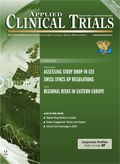How Will Technology Drive Global Clinical Trial Change by 2025?
Applied Clinical Trials
Exploring three pivotal technology areas that could reshape global studies over the next 10 years.
While personalized medicine and immune-based treatment approaches continue to drive novel efforts in drug development, they also contribute to the growing complexities of clinical programs. Fortunately, technological advancements foster the
Tina Siemens

evolution of clinical trials despite these challenges. Here, we examine how three particularly key technology areas could reshape global trials over the next 10 years.
Electronic medical records
In today’s clinical trial model, patient data flows from the patient/site to the sponsor and ultimately, and in aggregate, to the regulatory body. Electronic medical records (EMRs) provide a streamlined data flow-in some cases, directly from the patient to regulators. However, a lack of standardization has raised concerns over safety and security problems.
There are over 250 EMR providers registered with the Office of the National Coordinator for Health Information Technology (HealthIT.gov) in the U.S. alone. While the top five providers account for 50% of revenue, the lack of consistency and ability to share data effectively across EMR platforms creates tremendous challenges in the direct capture of trial data. HealthIT.gov abandoned its “Meaningful Use” implementation objective for electronic exchange of key clinical information in 2013 due to “technical and change management challenges.” These challenges are being addressed through various initiatives driven by regulatory and industry bodies and consortiums, yet will take time to address on a local and global basis. Registry data is one approach sponsors can use to access key patient safety and outcome data directly for trials. An example is the FDA’s Mini-Sentinel pilot project, which aims to monitor the safety profiles of post-marketed products using pre-existing electronic healthcare data from multiple sources, including EMRs and insurance claims.
Mobile and wearable technology
According to IHS, the wearable technology market will drive an estimated $30 billion in revenue by 2018. At a basic level, mobile technology is currently being used to increase patient compliance within studies through the use of mobile communication ranging from daily medication and clinic visit reminders to social media to inform and involve trial participants.
With the proper safeguards in place, medical tracking via wearables should advance monitoring and reporting. Opportunities include tracking and documenting insulin levels, cardiac activity, and respiratory rate. This type of visibility offers sponsors and CROs accurate, real-time data that would otherwise be difficult to manage. Take the study from Scripps Translational Science Institute published in the American Journal of Medicine, in which a wearable patch was compared with traditional testing to measure cardiac rhythms. The study found that the patch was preferred by the patient, was better at capturing data, and cost less for all stakeholders. As a result, the patch is now being reimbursed.
Data privacy
By 2025, improved data access and flow should become more the norm than the exception. But enhanced data access comes with concerns. We anticipate data privacy rules and considerations will become more complex, causing what could lead to significant changes to the now 19-year-old Health Insurance Portability and Accountability Act (HIPAA).
We already are seeing early signs of this with two separate bills introduced to address HIPAA and needed improvements to how a patient’s mental health information is disclosed to family members. A guidance document introduced by the FDA in March on modernizing informed consent through electronic informed consent furthers this point.
Tina Siemens is Executive Vice President, Clinical Monitoring, Novella Clinical
